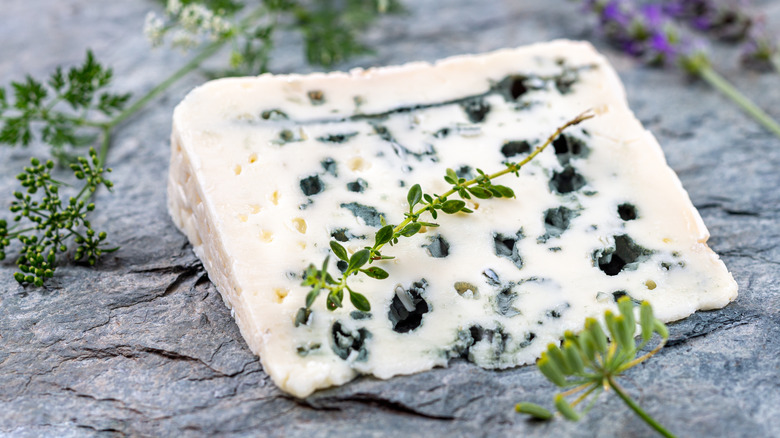How France's King Charles VI Helped Protect Roquefort Cheese
There are many types of blue cheese and just as many fascinating origin stories to go along with them. Picón Bejes Trasvisos, for example, was once wrapped in maple leaves when sold, but nowadays, gilded aluminum is used instead. Many kinds of blue cheese see tools of brass or stainless steel used to needle them (feeding their mold), but bone and wooden tools were once employed instead. One of the most mythical blue cheeses is Roquefort. Myth states a shepherd left his sheep's curd behind in a cave while pursuing a young lady. When he returned for it, the curd had transformed into Roquefort cheese (via Fine Dining Lovers).
What exactly is Roquefort, though? According to The Spruce Eats, blue cheese, in general, is made from pasteurized milk (including from goats and sheep), which is ripened with penicillium mold. The result is pungent, salty, and sharp, with lots of calcium, protein, and sodium, plus an edible rind. Textures vary, but bluish mold veins are quite common. Blue cheese originates from France and Italy, where medieval people inadvertently created it by storing cheeses in caves. Since then, blue cheese has spread across Europe and to other continents, mainly North America. Roquefort, as its folklore implies, is sheep's milk aged in French caverns until it turns blue, crumbly, and moist, tasting both sharp and sweet. As noted by Fine Dining Lovers, this blue cheese variety may date back to Roman times. However, its more recent history is decidedly French, not Roman.
A royal proclamation
Folks in the Middle Ages may have kept their cheese safe by storing it in caves, but these days, people have a more modern way of protecting their food. The European Union "protects" some classic, famous marbled cheeses by designating where they must be made in order to qualify as a particular kind of cheese. For example, Fourme d'Ambert is a Protected Designation of Origin (PDO) item that needs to hail from France's Auvergne region. At the same time, Gorgonzola is an Italian PDO that has to be produced in its namesake city (via Fine Dining Lovers).
Roquefort is similarly protected by law, according to the Milwaukee Public Library. The tangy, cool-color cheese must be aged in Roquefort-sur-Soulzon's Combalou caves in order to be designated Roquefort cheese. Anything else is an imitation. This particular practice began over 600 years ago, when King Charles VI of France decided to set up a monopoly, gifting the cheese to some of his royal subjects. Per Fine Dining Lovers, the French king was also called the Mad King and the Beloved. Per Encyclopedia Britannica, one of the monarch's rulings still endures. He loved Roquefort cheese, so in 1411, he designated its namesake locale the official place of origin for that blue cheese. The caves there became government-protected as a result. Whatever the rest of King Charles VI's rule entailed, most cheese aficionados can agree his idea to safeguard Roquefort cheese was a royally good one.

